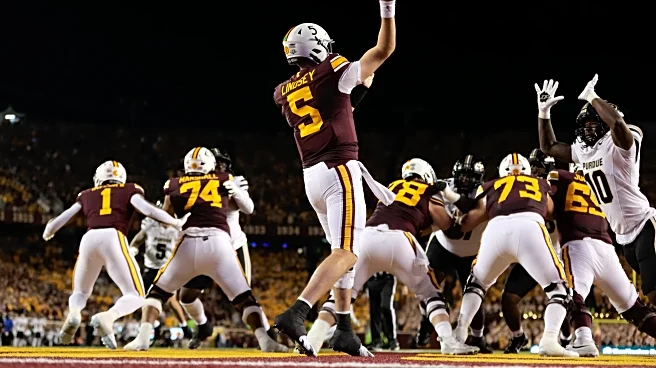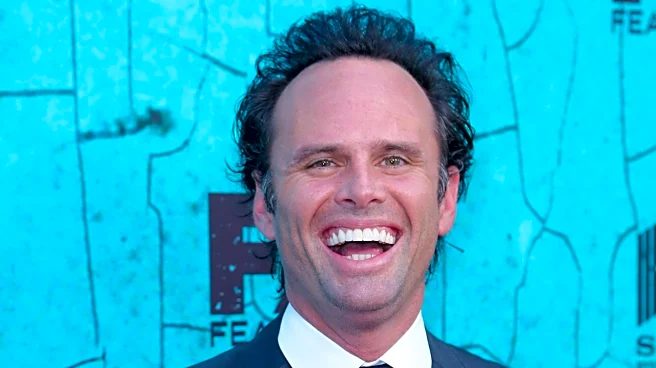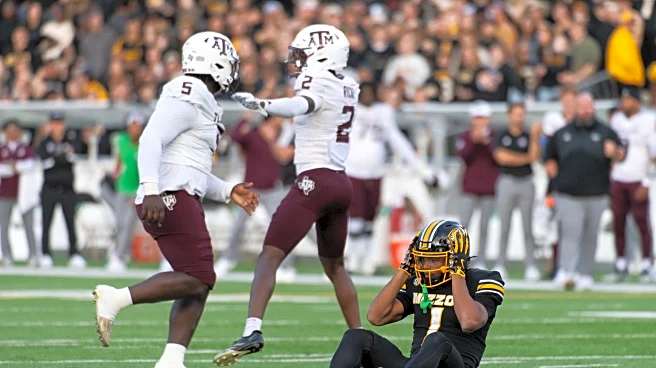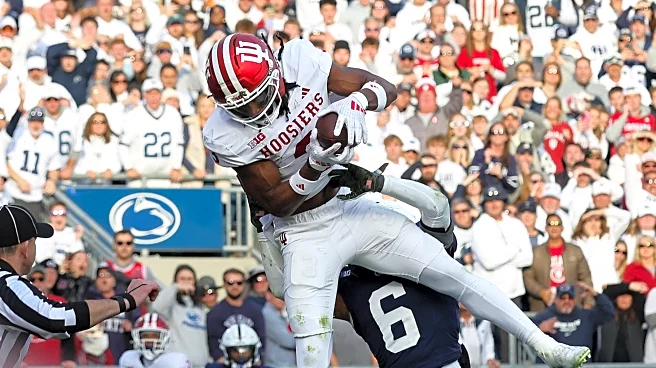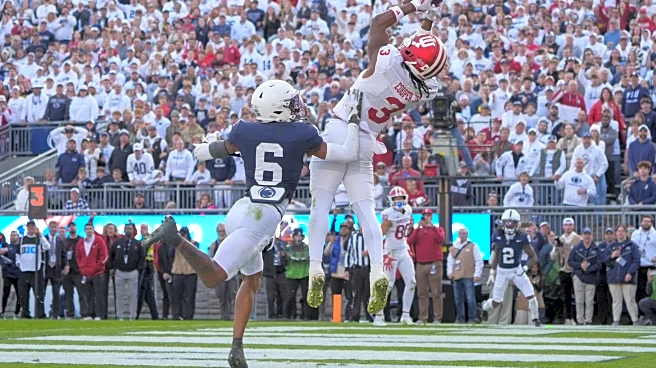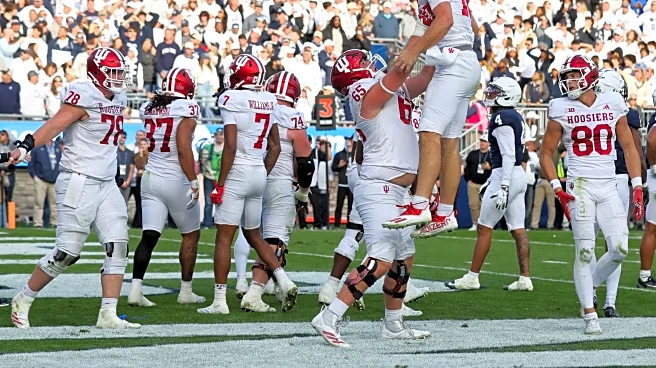Special thanks to Max Oelerking of Ski-U-Pod for discussing Minnesota’s roster with me on this week’s podcast:
https://playlist.megaphone.fm?e=RRTET3699356168
Minnesota’s 2025 season has at its core a major
paradox. Last year the Gophers, through a combination of a soft schedule and strength at some key positions, in my second-order win algorithm should have won 11 or 12 games on the fundamentals when grading them on a per-play basis … but due to conservative decisions in high leverage moments (what Max has called “Fleckisms” on the podcast) let four or five wins slip through their fingers and finished the regular season 8-5.
This year, each of those factors have flipped around. The schedule has gotten tougher and in every metric I track from charting Minnesota is performing worse on the fundamentals compared to last year — in some categories, significantly so — but evidently Coach Fleck has ratcheted up the aggression because the Gophers have won every game they’re “supposed” to in 2025. In this way, playing at a somewhat lower standard but not allowing games they’d all but won to get away, their record has balanced out to a similar keel, even though under the surface it’s a different team.
The offensive and defensive squads have paradoxes of their own as well. On offense, there’s been a major step back in overall performance, but on watching film I don’t think it’s because they’ve had a big talent drain – in fact, I like the upside of several key positions much better than in previous years, like the young QB’s arm talent, a mature and effective starting TE, an RB room I’ve always liked if they just had the blocking in front of them, some dangerous WRs, and finally moving away from a problematic center. But somehow the whole is less than the sum of its parts, as Max and I discussed – in isolation these guys show talent, but together they’re disjointed and out of rhythm. The upshot is that they can be dangerous at times, and have the potential to be much better than their numbers suggest, but we don’t often see it.
On defense, they’re on their third coordinator in as many years, and each new DC has gotten much more aggressive with the 2025 iteration being borderline reckless. I’ve never charted a more boom & bust defense on a drive basis – they kill about a third of opponent possessions with a negative play, often from blitzing and/or crashing the defensive backs, but another third of possessions end in a touchdown resulting from surrendering a super-explosive (30+ yd) play, often though not always precisely because those extra defensive resources are absent from the backfield. And in between, the Gophers have virtually no methodical drives on their sheet – so it’s kill or be killed, nothing else, all of which are significantly outside of FBS norms, and whether they win or lose the game has most often come down to the simple question of which of the two happens more often.
Offense

The Gophers are more than a full standard deviation below FBS median in all six major offensive metrics I track from charting, down in each of those categories — where they were already a tick below average in 2024 — compared to last year. Personnel losses at offensive line and wide receiver without great adaptations in scheme from OC Harbaugh (no relation to the other football Harbaugh clan) to use their replacements are the most obvious culprits, which Max and I discussed at length on the podcast. But the new young starting quarterback, redshirt freshman #5 QB Lindsey, requires some unpacking.
The longest tenured QB for Coach Fleck was Tanner Morgan, the starter for five years from 2018 through 2022, with an NCAA passer rating that hovered above and below the FBS median and finished with a career average of 151.0, about half a standard deviation above. Lindsey reminds me quite a bit of Morgan, and when I asked Max if he thinks the plan is for Lindsey to be the next career Gopher starter he said absolutely.
While he’s very young and I certainly think there’s room for growth and better processing, and pocket escapability is a concern, Lindsey’s arm talent on film is simply easier and more natural than the last two Minnesota QBs, to my eyes: he already has far more touch and control than the big-armed but unrefined Athan Kaliakmanis did until his senior season, and Lindsey can paint all four corners of the field unlike the volume of short passing that FCS transfer Max Brosmer did last year.
In balancing where Lindsey’s development is at currently vs his longterm upside, I think his youth probably contributes a couple of points’ worth of falloff in the passing game, but hardly all or even most of it. I think the decision by Harbaugh to make this a 65% passing offense on 1st downs and overall, and not use the run game to relieve the pressure on a young QB and a suspect WR corps, is a peculiar one, though with the offensive line grades I’m not sure how much of a difference it would make.
In terms of efficiency, the best passing target has been redshirt senior #86 TE Geers, with a 62.5% per-target success rate given the down & distance on 31 meaningful targets this season, though a below average (everyone on this team has below FBS average numbers) 6.0 adjusted YPT as just about everything he’s catching are quick outlets and dumpoffs. The second tight end is Purdue transfer #87 TE Biber, with about half as many targets and a similar depth, but much lower success rate at 46.5%.
One of the tensions that Max and I discussed on the podcast is that Geers also grades out as the most effective blocker on the team — at any position — and the Gophers are often in a bind in that they need all the extra blocking help they can get but keeping the TEs in means fewer potential targets released into the pattern, and in the person of Geers, being without their most efficient.
The most targeted wideout is redshirt senior #0 WR Brockington with 55 meaningful targets. This season he’s produced pretty mediocre numbers, a 55% success rate and 7.5 adjusted YPT, though his production in previous seasons when they had guys like Daniel Jackson and Elijah Spencer suggests to me that Brockington is more talented than these numbers indicate. Max agreed; his theory is that defenses know that they really just need to guard Brockington and without other real threats to divide the defense he’s hit-or-miss to win heavily contested balls.
The other two frequently used receivers are Miami of Ohio transfer #11 WR Tracy, who can be very dangerous as a catch-and-run receiver if he can evade or break tackles as he has a number of big plays that way but overall has turned in a subpar 43.5% success rate and 6.4 adjusted YPT numbers, and redshirt freshman #8 WR J. Smith who I think is their intended deep-shot option but with whom Lindsey has really struggled to connect on a variety of issues resulting in a very poor 37% success rate and 6.8 YPT.
There’s also UCLA transfer #11 WR Loya, who at his last school was one of the most consistently effective receivers in both conferences I charted him in, has the highest per-target success rate of the WR corps this season at 57%, looks to have good chemistry with Lindsey to me, and according to Max has been available all season … but for reasons that surpass understanding Harbaugh only puts him on the field for 6% of snaps, and Loya only has 11 meaningful targets all year for a paltry 4.6 YPT.
Here’s a representative sample of successful passing plays:
- :00 – Good quick release and velocity on the opposite hash throw to Brockington, the corner’s stumbled but he was outleveraged anyway.
- :13 – The LG’s beaten and nobody’s open so it’s time for another dumpoff to Geers. Lindsey switches up rapidly and gets it off – there’s two backers on him so he’s not getting anything extra but he gets just over half the distance on 2nd & long.
- :28 – With Oregon’s luck I fully expect Minnesota to slap their collective foreheads, remember that they have Loya, and throw him 20 passes on Friday. Nice throw in rhythm here, it’s a little behind Loya because of the traffic in front of Lindsey but you can see his great hands at work putting it away without losing momentum and gaining 8 yards.
- :47 – This is what Tracy does best, I left five other plays that looked exactly like this in the cutting room – little in breaker, jump catch, then running laterally across and down the field while evading tacklers and making the defense look silly.
And unsuccessful passing plays:
- :00 – Almost in the redzone, Minnesota wants to take a designed shot play … releasing only one receiver into the pattern, while one of the tight ends, the RB, and another receiver are all staying back to protect. It’s not going great, Tracy is locked down by single coverage from maybe the worst secondary in the conference, the backup LT isn’t having a good time, and Lindsey doesn’t have an outlet so he just runs for a bit and falls over. Max and I talked about screwy play designs like this not helping out the young QB.
- :25 – The defense is rushing four and playing man with a robber, which is what you do when you simply out-talent the offense across the board. There isn’t an inch of separation anywhere, there’s no scramble lane, and the pocket collapses within 2 seconds with no extra personnel. Lindsey makes a break for the sideline but he doesn’t have the escapability for it and has to throw it away as he’s falling to conserve yardage.
- :59 – Here’s Smith running the post. I’ve spent a while trying to parse which end the communications problems are on and am throwing in the towel, I think they’re both young guys. On this play both the route and the ball are too deep given the coverage with the bailing bracket help – the DB has downfield position so the frictioning is legal and the right thing to do is break it off at the 40 and play it underneath, and the QB has to know it and take something off the throw. Neither happen so it’s incomplete, Smith’s 5th of the day on his targets, with a risk of a pick.
- 1:20 – The reader can see the rightside / leftside difference in protection quality, it speeds up Lindsey’s timer and his throwing motion suffers badly for it with a really awkward launch so the ball sails. I’ve seen this Iowa DB get cooked repeatedly by a variety of Big Ten slot receivers so Tracy never getting even with him in this game explained a lot for me.
It seems clear from the substitution patterns, prior experience, and effectiveness that the intended starting tailback was #1 RB Taylor, who in his true freshman season in 2023 graded out as one of the most effective backs in the Big Ten and one of the few highly explosive ones. However, injuries and mounting offensive line problems in 2024 and 2025 have significantly cut into Taylor’s per-carry efficiency the last two seasons. This year Taylor has missed time on two occasions, one early on against Cal, and the other most recently which Max said he expects to continue to keep him out on Friday.
Due to that missed time, the back I believe would be the second-string has actually gotten the most meaningful carries, redshirt freshman #7 RB Ijeboi. Max told me he’ll probably be the primary ballcarrier on Friday, as he was in the previous three FBS games that Taylor was out. It’s hard to say where Ijeboi’s true ceiling is compared to Taylor since I’ve only seen Ijeboi running behind a line with some real problems, unlike Taylor’s 2023 season with proper blocking, but in 2025 they have nearly identical per-carry numbers at 44% success and 4.2 adjusted YPC.
The third back in, and second with Taylor out, is UW transfer #23 RB C. Davis. His success rate is also underwater, but he’s coming in at only 2.3 YPC. Davis’ utilization has been somewhat different – they’ve used him more in pass protection and a much higher skew of his touches have been pass targets (40%, double the rate of the other two), and during the three games Taylor has been out a higher proportion of the short-yardage carries have gone to Davis than Ijeboi. However, Davis isn’t actually successful at any of these things: his pass-pro grades are below average, his YPT is 3.9 which is half of Taylor’s (though double Ijeboi’s eye-watering 1.8), and Ijeboi beats him by 12 percentage points in short-yardage effectiveness.
After a peak in 2023 that I had really respected OL coach Callahan for, the story of the offensive line and its downfall through, in my opinion, mismanagement over the past two seasons is almost operatic in scope. The reader can return to my 2024 and 2025 Summer previews for a full recounting. The upshot is that the Gophers needed to replace a left tackle who was drafted in the second round, two sixth year senior starters who I believe were good enough to be drafted but management problems and injuries kept them from the NFL, and two more starters who transferred out and are now starting on other Big Ten teams.
For this season they returned the two weakest starters from last year (if that math doesn’t seem to check out, reader, you are cottoning on to the management issues I’ve alluded to), #65 OG G. Johnson who should not have been playing center but was in 2024 anyway, and #78 OG Beers who was on and off the bench at different times last year. They’ve swapped the positions of those two, so Johnson is now at LG and Beers is at center, which is an improvement in that snapping and blitz communications are not an utter disaster now, but not significantly in actual blocking.
The new starters are redshirt sophomore #50 LT N. Roy, UCF transfer #74 RG Marshall, and Kentucky transfer #73 RT D. Ray. The left tackle Roy is getting his first play this season and a bluechip recruit, who looks to me to have the highest upside though I still see a lot of rawness in his game, and I think he makes sense as a longterm investment.
I don’t understand what they’re doing on the right side though; Max and I both bemoaned constant collapses on the right as the single biggest problem with the offense and an absolutely baffling lack of just raw strength here as the line loses ground instantly off the snap. It’s very puzzling that they would flip Marshall, a longtime left tackle at his two previous schools, to guard, and Ray, who was an ineffective interior lineman at UK and WVU, to tackle; even more so to play two transfers instead of relying on the internal development Callahan was known for with six other returning backups besides Roy in the room.
Here’s a representative sample of successful rushing plays:
- :00 – Typical run for Davis from the last time Taylor was out. Geers has the OLB sealed so the D-gap is there, Davis gets up to the backer and … that’s all.
- :08 – Ijeboi just doesn’t like the designed hole, the d-line isn’t under control and his angle to get there is a lot harder with the center running that far into the offensive backfield. Good decision to junk it and bounce, and nice juke of the DB.
- :23 – This was the only game all season when Minnesota’s line could just lean forward and get whatever they wanted, no dancing from the backs required, and they got literally five times the rushing yards as Nebraska (there’s something peculiar about this series and the Minnesota-Iowa series over the last decade). They just plowed forward for four yards from the I-formation at will.
- :30 – This double whammy really faked out the defense, under-center to fake play action to a draw play gets them to back out and play the pass just as the o-line releases to block them all out. I chose the play to show Ijeboi’s combination of burst and some nice fight at the end for extra yardage.
And unsuccessful rushes:
- :00 – This was the second of two consecutive short-yardage rushes that Davis didn’t pick up. I don’t really think he does anything wrong here so much as the timing is off from the snap and the line’s not winning — I’ve generally thought Davis’ entire career has been snakebit, this is kind of a microcosm — but he doesn’t do anything extra or special to get the conversion either.
- :33 – There’s a noticeable disparity, -16 percentage points, in success rate on outside zone to the right vs the left, though it’s not like the backside is covering itself in glory either..
- :42 – This has just been the biggest problem, it took a while to articulate on the podcast but it’s immediately obvious on film – the line just gets blown off the ball. Against Iowa, which is a bend-don’t-break defense that pointedly does not stuff the run against most teams, Minnesota’s line was getting ragdolled.
- :54 – I like Ijeboi’s instincts and cuts to avoid contact but there’s only so much he can do; here he dodges penetration from the RG and RT both releasing the DT to go downfield — that can’t be right — but his sidestep just takes him into another DT who’s penetrated because the LG got knocked over and the C was crushed.
Defense

When former defensive coordinator Joe Rossi left for Michigan State after the 2023 season, Minnesota hired rising star Corey Hetherman, the linebackers coach then at Rutgers who was credited with revitalizing the Scarlet Knights’ blitz strategy. Hetherman kept the Gophers’ same basic 4-3 / 4-2-5 structure but flipped the defensive philosophy from Rossi’s conservative approach to a more attacking one featuring early-down blitzes. Max approved when we talked on the podcast at the time, and when Hetherman was hired away by Miami for the 2025 season and Minnesota promoted longtime DB coach Collins to the position, Max’s hope was that Collins would keep up the aggression rather than return to his old boss Rossi’s approach.
Max got his wish and then some, because the 2025 Gophers defense is far more aggressive still. The blitz rate has increased to nearly 40% on early downs which is almost unheard of, and defensive backs are used extensively in the box both against the run and in pressure packages, meaning the back end plays a high risk / high reward cover-1 on over 70% of meaningful snaps.
The result is a kill-or-be-killed set of drive outcomes – methodical scoring drives from opposing offenses without negative or explosive plays are essentially non-existent (these typically make up a quarter of possessions), while simple 3-6 play drives with one or fewer conversion with no negative or explosive (that is, a methodical in which the offense just fails to convert more than one 3rd down) which typically make up 40-60% of a defense’s portfolio are only about 30% of Minnesota’s.
But the drives on the extreme ends of the bell curve, which are typically 10-15% of possessions, happen at double normal the rate for Minnesota: on about a third the Gophers get a sack or TFL which immediately kills the drive within a play or two, and on the other end another third of drives the Gophers give up a super-explosive play of 30+ yards which either scores a touchdown itself or puts the offense on the doorstep and a touchdown becomes all but inevitable.
Here’s a matched pair of examples from every game:
On the podcast, Max and I discussed how this situation is both an adaptation to the personnel, but also creates its own self-fulfilling prophecy. I think Max is right that the players in the defensive front are, generally speaking, stronger than the secondary, and so a strategy of leveraging the front to shut the play down fast before it can get to the backfield makes some sense – I certainly see a number of very big plays given up regardless of the pressure strategy simply because of blown coverages and missed tackles by the DBs.
But it’s also clear that there’s a strong correlation — although not perfect, there are plenty of exceptions in which pressure gets home or an explosive is given up when they’ve taken a break from the hyper aggression — between using extra defensive personnel for pressure, putting the secondary into a higher stress posture and/or just taking a DB out of the backfield and crashing him, and now being very thin if the play gets through anyway to stop a big play from going very big.
The returning senior starters at defensive tackle are very good, #91 DT Eastern usually at 1-tech and #97 DT Logan-Redding usually at 3-tech. Over the Summer Max and I talked about depth concerns behind them due to some transfers and how much they played ironman in 2024, and they got some bad injury news to a couple of guys we had mentioned on the podcast; however the rotation has turned out pretty well for all that. #16 DT Lawrence, who’d bounced from the FCS to Juco and back since 2019, has played much better than I might have guessed and actually has a higher tackle count than Logan-Redding, though the starter grades out a little better in meaningfully affecting the play. And in a real surprise, redshirt senior #89 DT Becker, a former walk-on, has gotten the fourth spot – he’s built more stoutly and needs to bowl over a weaker lineman to get the same havoc as the other guys, but he’s reliable as relief so the fatigue issues of last year aren’t in evidence.
The main havoc producer at defensive end is returner #0 DE A. Smith, who was a big part of the productive rotation last year and at 285 lbs plays on the strongside. On the weakside, 230 lbs #11 DE Menz has stepped up — he’s a returner but I didn’t see him at all last year — and is producing a lot of havoc especially in recent games off the edge. Former LSU transfer and mid 4-star from the 2023 cycle #1 DE Howard was a deep backup last year but is in a sense a co-starter with Menz now – at 245 lbs Howard can play on the weak or strong side so he replaces Menz against certain offensive looks and Smith when he’s taking a break. Completing the rotation are 6th year #46 DE Finnessy and redshirt freshman #98 DE Kissayi, both of whom are substantial steps down in performance on my tally sheet but at least keep the ends at the playable five-man group the staff seems to prefer from the last few years.
At linebacker, the starters as expected (they were thrown in earlier in their careers than might have been expected due to a very complicated injury backstory and Minnesota’s habit of playing a glut of backups in a variety of roles which your assiduous film reviewer has been tracking to almost no productive end for years) are #6 LB Baranowski and #9 LB D. Williams, with #49 LB Kingsbury as the SAM for 4-3 configurations as well as the backup for Baranowski or Williams in the 4-2-5 when either need a break. There are a couple of other players who’ve seen meaningful play listed as linebackers, #2 LB Karno and #19 LB Gerlach, but I’ve only seen them go in on 3rd downs up on the line of scrimmage as part of specialty pass rush packages.
It’s a challenge to get a clean read on this because the significant scale up in aggression this season has meant they’ve been deployed differently, but using my best efforts at data controls I cannot report much progress from the starting linebackers at the issues Max and I have discussed in the past which have limited their effectiveness – Baranowski’s agility and burst appears to have a hard cap, while Williams and Kingsbury do not have high marks identifying the play and scraping properly or anticipating in coverage. I have linebacker problems as the major contributor to Minnesota being underwater at 2nd & short/medium and 3rd & short pass conversions as well as their abysmal 28% defensive success rate against the run on 2nd & short/medium.
Here’s a representative sample of successfully defended rushing plays:
- :00 – Note the aggressive defensive posture – both DTs and the end Smith inside the tackles, the other end Howard standing up with the backer Williams on-ball opposite, and a DB in the box who’s going to come down on the run as a quasi-backer. Smith is free to fire inside the tackle immediately since Williams is setting the edge and the o-line can’t clear him or Eastern, and there’s not enough blockers left for the backers. Of course, the QB keeping the ball instead of performing a salsa clave clap would have gone big.
- :15 – That’s Menz on the weakside opening the B-gap for Williams to knife in, and note the DB switch-up with the nickel over the TE spinning back and the boundary safety crashing.
- :27 – The one down & distance situation where Minnesota overperforms their global average is 3rd & short, where they’re at 51% success instead of underwater. Iowa telegraphs this play from the empty formation (which a certain DC ought to have known); Minnesota’s front knows what’s coming and gets penetration to shut it down.
- :39 – The Gophers really overmatched the Spartans o-line and felt free to run blitz – it’s 12-personnel and everybody is covered even with two safeties back as the DL plus a corner and LB can take care of these blockers without trouble. Menz alone, the least heavy DL, occupies three blockers himself.
And unsuccessfully defended rushes:
- :00 – This kind of overpursuit on splitflow has been fairly common, Logan-Redding and Becker completely run themselves out of the play thinking it’s wide zone to the field, while Baranowski chases the slicing TE who’s just a blocker and Williams whiffs after getting the mildest hip check I’ve ever seen.
- :21 – Max and I were both puzzled that Minnesota doesn’t run gap schemes on their own offense more often — they’re so rare I didn’t have any good clips to use — and it must be especially galling because they have nearly a 70% success rate against against the Gophers’ defense. Here Purdue is pretty easily displacing the Minnesota front with backups in at DT and DE. With the formation into the boundary and Howard slow to figure it out and get across the formation, Baranowski has both pullers in his face and mauling him 15 yards backwards.
- :41 – This was big wince. The CB chases a real motion then imaginary reverse so he clears himself out of the play, while the entire front chases the RB including Smith who should be setting the edge against exactly this keep, and Gerlach defines overpenetration.
- 1:04 – Once again, Minnesota’s hyper aggression is used against them on this counter play, when the entire defense falls for a bit of counter motion and there’s a great big hole on the other side to run into. On the endzone camera angle, take a look at all the defenders’ shoulders and pause it at the moment of the handoff – note that not only is everyone running down the line, they’re not parallel to the line of scrimmage with sound bases, they’ve just turned their whole bodies and are sprinting. This makes them easy to block down and hard to turn themselves around – that’s why the DT can’t get to him even after winning and the DB whiffs on the tackle as the RB runs past.
There are a number of factors that make it tricky to describe the secondary. For one thing, injuries and possibly one DB losing his job have resulted in six guys shuffling around in four of the five spots, with only one of them — boundary safety #3 DB Perich — in the same position all year long (and he’s the one they’ve had play on offense, return kicks, and put most frequently in the box!). For another, the constant pressure demands put these guys in high stress situations and kind of makes me want to grade them on a curve. Finally, while there are definitely certain aspects of play that I have strong criticism for, there are also other aspects of play which are very good from the same guys … I can see why they won starting jobs and the staff is reluctant to take them off the field despite manifest breakdowns, so they defy pat descriptions.
The cornerback rotation, such as it is, has been simpler to understand since it looks to be entirely about injuries. The starters at the beginning of the year were returner #4 CB Bryan and Iowa transfer #17 CB Nestor, with TCU transfer #24 CB McMillan as the primary backup and redshirt freshman #13 CB Gerald as a deeper backup. Nestor missed one game with an injury and McMillan took over, but at that point Gerald got dinged up and it was apparent they didn’t have anybody else playable. Nestor has returned for the most recent two games but Bryan hasn’t been able to start (Max told me an insane story about him being injured during warm-ups). Max said it’s anybody’s guess who’ll be available on Friday since the program releases no information and the injury history here is just so bizarre, but not to expect much in the way of depth.
Bryan strikes me as the most fluid of the trio while Nestor is good in run support, McMillian is a bit of a jack of all trades, but they all look undersized to me and their coverage and tackling grades are poor. I don’t think the constant cover-1 (man coverage with a single-high safety who’s rarely in position to help them deter a pass) is doing them any favors and as we discussed on the podcast I probably would have deployed a zone scheme if I knew I had this personnel.
I’m still not sure what’s gone on with the field safety and nickelback positions, and Max told me it’s tough to get anything but elliptical answers out of the program on this matter. At the beginning of the year #7 DB Gousby had resumed his starting job at field safety from last year while returning starter #14 DB Brown moved over to make room for Perich and take over for the departing starter at nickel (Perich was a frequently used backup last year who saw a lot of starting time as a true freshman due to injuries).
But then midway through the year, Gousby either got hurt or benched or both (I suspect short timeframe injury, then available as a replacement and dime package guy but no longer preferred as starter), Brown flipped over to be the new field safety, and #12 DB Green — a veteran from the 2021 class who missed all of 2024 with an injury — came in to take over at nickel. That’s been the arrangement ever since, although in the most recent game Brown got dinged up and Gousby came back in.
All four of the safeties I’ve mentioned have terrible grades on my tally sheet. Perich has the best excuse in that he’s deployed the most aggressively and he rescues the most plays, though when he’s out of excuses I constantly have him taking bad angles and tackling with the wrong leverage. Green is coming off a long layoff although he’s now been playing for several weeks so that excuse is wearing thin, but I don’t understand what’s happened with Brown and Gousby, who graded out pretty well as starters last year in a top-rated defense but now are whiffing on tackles at an appalling rate.
Here’s a representative sample of successfully defended passing plays:
- :00 – Smith wrecks the 3rd string LT for a sack … and a good thing, since the DTs are getting nowhere and the RB picks up Howard after he gets past the RT, and a miscommunication in zone between Nestor and Perich leaves the slot fade for a TD wide open.
- :23 – Ohio State’s o-line: still oversized JAGs who are prone to getting beat and holding.
- :56 – This is what most deep shot pass defenses looked like – an extraordinary amount of defensive resources hanging around the box while the back end was sparsely populated and struggled to keep up, and then just betting the QB would miss an a receiver who cooked the coverage. Since he wasn’t playing against the Ducks, of course the QB missed badly.
- 1:20 – Plays like these are why I hesitate to write off the secondary as a lost cause, I just don’t think that’s true because I see plenty of talent flashing, especially with Perich. This looks like man/zone confusion with Nestor and Green against the scissors concept, and with the blitz picked up it’s a sure TD … but Perich reads the mistake and books it over in time for an excellent and 100% legal PBU.
And unsuccessfully defended passes:
- 1:22 – The only thing that graded out worse than cover-1 was the fire zone … there are two men in the pattern with six in zone and they still aren’t covering a soul, with a 10-yard halo of defenders around the receiver. And then there’s the tackling, oh my stars and garters.
- :00 – One consistent theme I noticed for neutralizing the pass rush was QB rollouts. Here Gousby is part of the blitz and vacates the space the QB wants to throw into, but accomplishes nothing for it, while the backers are sucked in by just the suggestion of play action before the immediate rollout.
- :23 – Great penetration by Smith and Eastern, but this ball’s out too quick – Baranowski has drifted out of the throwing lane (he needs to keep inside, the CB has the outside leverage) and Bryan is beat off the break, making this an easy decision for the QB.
- :45 – Minnesota has eight in the box, with their 4-3 configuration plus Perich on ball. It takes a DB out of the safety net, which they’ll desperately need, and it doesn’t help any, since this is technically an IDP as the line gets demolished so badly the LT is over the 49 when the ball is released. Nestor’s leverage and breakdown are … poor, and the angle Brown takes to rescue the play is suboptimal as the trigonometric intersect is at the 34.5.
